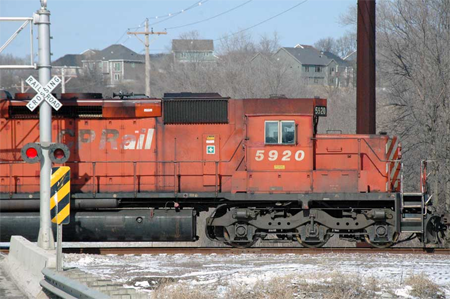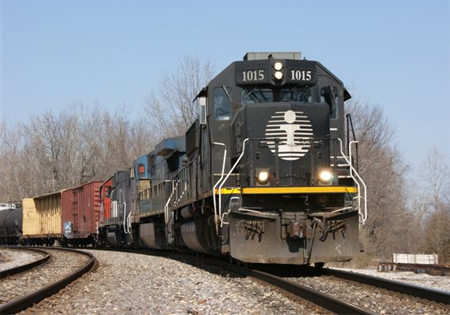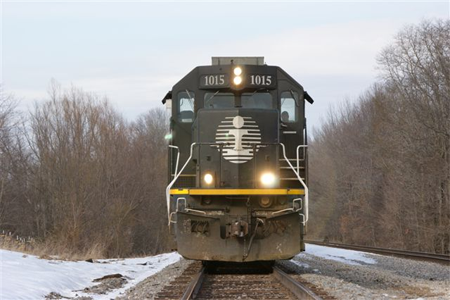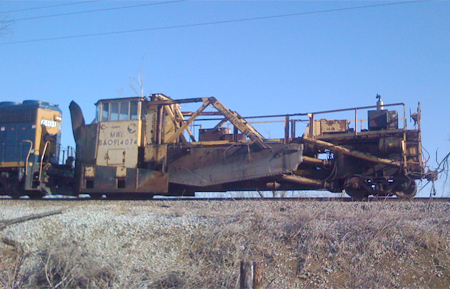Month: March 2009



Spring Garden RR Gathering at home of Bill and Angela Thomas, 1025 Lakewood Drive, Madisonville, has been re-scheduled for Saturday, May 9, 2009. 11 am to dark. This is a drop-in event so come when you can and bring your large-scale (45mm gauge) equipment to run. I have a couple of transition cars for hook and loop to Kadee couplers. Live steam, battery power, and track power are all welcome. Light snacks will be served. Parents, please accompany children 12 and under.
From: http://www.trainfestival2009.com
Saturday July 25 and Sunday July 26, 2009. Enjoy a steam excursion powered by PM #1225 (Sat.) or NKP #765 (Sun.), two of the largest operating steam locomotives in the world. These special trains will leave Owosso at 9:30am sharp headed to Alma. Once in Alma, you will have the opportunity for lunch and shopping on your own. After a 2 hour layover, the train will return to Owosso. A photo-runby will be
included. Admission to the event is also included in your ticket. All ticket prices are $90.00, no charge for children under 2. See website for additional info.
JACKSONVILLE, Fla., (March 17, 2009) – CSX Corporation (NYSE: CSX) will present its first-quarter earnings on Wednesday, April 15, 2009, at 8:30 a.m. Eastern Time via teleconference and live internet webcast. The company expects to issue its first-quarter financial and operating results after the market close on Tuesday, April 14, 2009.
Those interested in participating via teleconference may dial 1-888-327-6279 and ask for the CSX earnings call. (Callers outside the U.S. may dial 1-773-756-0199.) Participants should dial in no later than 10 minutes prior to the call.
Presentation materials and access to the live webcast will be available at www.csx.com in the Investors section.
Following the earnings call, a webcast replay of the presentation will be archived on the company’s web site. In addition, the replay will be available for download to a portable audio player or computer as a MP3 (or podcast) file. Both the replay and MP3 file will be available through the Investors section at www.csx.com. Submitted by Jim Pearson.
Having been track side more lately, what building a house in Mortons Gap, I have seen a few interesting things go by on CSX. My new house under construction is right in Mortons Gap at Walnut & Railroad Streets. This is right by the old L&N Mainline just a few yards south of Morton Junction or South Mortons as it is called. This is where the line from downtown Madisonville joins back in with the line around town by the Parkway Plaza Mall. I spend a lot of time here now as I am building the house myself.
CSX provides me with several excuses to take a break every time I am here. In so doing I “witness” quite a few odd things on the railroad. Perhaps odd is not the correct word to use but it will do. I have seen a lot of lease power mixed with CSX’s stable of locomotives. Some of these are in lease company colors while several wear their former owner’s paint. Most that are still in their previous owner paint have had a rectangle decal or painted box applied over the former road number and a new number applied. Most do not match the faded paint or are a different color all together. Most that are still in former railroad paint will have the railroad name painted over and the lease name or usually just the initials painted or decal applied. Some are very well done while others are crude and hurriedly applied. I guess a locomotive is not earning revenue sitting in a paint shop.
A model railroader could use this to his advantage. There are so many ready to run locomotives on the market in all scales that could have a decal applied right over the road name and still be appropriate, even if the old name is legible beneath the new name. And that lease name could be anything or any one for that mater.
The same goes for rail cars. I have not taken time to count but it seems about one in three cars have had the owner marking changed at some point. I am sure some of these are the result of mergers in the finance world as most cars are owned by a trust company and leased to a corporation or railroad. Some are old and have been rebuilt and sold to new owners thus a change in nomenclature. One interesting note is old fallen flag railroads that have had their name re-applied to freight cars. CSX ended up with the paper assets of the old New York Central Railroad. A lot of CSX cars are lettered NYC or NYCX. Norfolk Southern has the Pennsylvania Railroad holdings thus a lot of cars are around with PRR on them. It seems odd to see a brand new rail car with NYC markings.
And of course it seams as though foreign railroad motive power shows up on just about every other train. This is my favorite, to see a UP or BNSF units on a train, NS too but very few others. I have yet to see an ICRR or KCS locomotive on the line. I am sure it has happened but not while I am watching. I do see a lot more “old” CSX locomotives than I would have thought. There are still a lot of SD-40-2 units on the railroad. I remember about twenty or so years ago several guys went to eastern Kentucky to seek out the then new SD-50’s. These units were only in the coal fields of Eastern Kentucky. Then they started to make their way over the railroad and could be seen here quite often. Now they seem to be rare. GE’s are every where it seems but EMD MP15’s must be in use everywhere too. I see these little guys in consist with their big brothers every so often. They are always last in consist and in tow. But I see them going both ways seemingly on regular bases.
Odd freight cars show up too. Do not look away from a seemingly boring train, you will miss something or see a strange sight after it has past you, leaving you to want for more info. I have seen strange flatcar loads, farm machinery being my favorite. Odd specialty cars such as tank cars for strange gases seem to be odd shaped things or overly large. One recent sighting was a low slung, quite long flat car with two four wheel trucks under each end. The lettering was very small making it impossible to read and get a look at the car too. The bogie was a casting and unusual it seems. It was not a D.O.D. car for military loads and was empty. What was it and who owns it?
I have seen dangerous sights too though not too many. Shifted loads on flat cars. Dangling straps and plastic streamers are common. I have not seen any riders…yet, but I am sure they are there somewhere. And of course there is the ever present graffiti on cars. Some of those guys do have talent just wrongly applied.
The next time you are track side watching trains or watching for a train take a look at the road bed. Chances are you will find something that was or is supposed to be on a car or even a locomotive. Case in point. Do not get too close to the track when a train is approaching. You could end up with an unpleasant surprise.
So, if you need something else to keep up with in this hobby, start a list or a photo album of “odds” on the railroads. Could be a fun hobby with a hobby.

The following was copied directly from Amtrak’s website, www.amtrak.com.
Amtrak Corporate Guidelines on Photography and Video Recording:
Section I. Policy
The taking of photographs and/or videos is permitted within public access areas on Amtrak property and as otherwise stated in Section III. In emergency and/or special circumstances (for example, declared elevation of Homeland Security Advisory System to High or Severe – orange and red) and where actions are deemed suspicious or inconsistent with this policy by observing/reporting persons, photographers and videographers may be approached and questioned to determine if further investigation or action is necessary. Photography and video recording within restricted areas are prohibited. Individuals found in a restricted area will be subject to investigation and possible arrest and seizure of photography and/or video recording equipment may occur pursuant to the arrest. This policy applies in all circumstances, including where Amtrak may be promoting a photography contest or event.
Section II. Definitions
Commercial and Special Photography. Photography that requires explicit authorization from Amtrak and includes engagements for commercial gain or profit such as, movie films, commercial television productions, and photography for commercial advertisements. Photography. Photography shall mean the taking of moving and/or still images. Public Area. An area open to general public access and occupancy (station areas and platforms for ticketed passengers only) that is not otherwise posted or restricted by posted signs or locking devices. Signage, building design and physical barriers, i.e. fencing, bollards, etc., may also distinguish a public area from a restricted area. Restricted Area. A restricted area is any area not open to or occupied by the public, or is open to or occupied by the public on a limited basis. Signage, building design and physical barriers, i.e. fencing, bollards, etc., may also distinguish a restricted area from a public area.
Restricted areas include but are not limited to the following: Platforms (ticketed passengers are exempt); Crew and Employee Work Areas; Maintenance Facilities; Unoccupied Trains and Engines
Office Areas; Employee Elevators; Baggage/Delivery Areas; Commissaries; Right of Way and Track Areas; In service train cars. Find more at www.amtrak.com. – Submitted by Jim Pearson
In the January 2009, issue of The PennyRail two photos captioned as locomotive 2086 appeared: the older one taken at Earlington in its original configuration—capped stack and oil headlight. The second picture taken at East St Louis near its end of service, with a straight stack and electric headlight.
However, I believe the last two digits in the caption were transposed, and that the locomotive shown is actually 2068. (Editors note: Mr. Millen is correct, the numbers were mistakenly reversed in the caption.) For many years engine 2068 was assigned as the Earlington switcher. I grew up hearing about it, and think I remember having ti pointed out to me as a small boy in the early 1930s. In a remote sense, I guess I can even claim that it played a part in my entry to the world!
The story I heard many times growing up, was that Dad (Harry Millen), promoted as Engineer the last day of 1918, being lowest on the seniority list, could only bid on a running job on the Earlington switcher. Mom (Mildred Shaver, whose father Elmo, was also an engineer.) graduated Earlington High in Spring 1918, having learned typing and shorthand. Elmo was able to get her the job as stenographer, assigned to the Master Mechanics office in the L&N shops at Earlington. She said one day walking through the yards from the shops to the Division headquarters on the second floor of the Earlington station, which from time to time her duties required, she say Dad running engine 2068. Then and there she decided to “set her cap” for him! As things progressed, occasionally he was able to run 2068 south on the main the seven or eight blocks to the Shaver home at 705 West Side Avenue alongside the grade, and give her a cab ride to work. One time he showed her the throttle and told her to pull on it to start forward. She did—too much of course, and my, how the drivers spun and the exhaust roared! Since 2068 became Dad’s “court’n conveyance” can’t you see how I feel it’s a little bit responsible for my existence.
Richard Prince’s Louisville & Nashville Steam Locomotives (1968 Rev, Ed. , p. 50) lists class B-5 0-6-0 switcher locomotives numbers 2060-2069 built by Baldwin in 1903-4. They had 20”x26” cylinders, 180 lbs. pressure, 52” drivers, and 30,600 tractive effort, weighed 143,000 lbs. All in B-5 class were retired during the years 1934 to 1951.
However, if I am wrong in my surmise that the picture was inadvertently mis-captioned, I must also report that the L&N did roster a #2086. It was in Class B-4, numbers 2084-2089, built by Manchester in 1907, and retired beginning 1946. Unlike the capped stack of the early photo of the 2068 taken at Earlington, a builder’s photo in Mr. Prince’s book (p. 52) shows a unit of the Class B-4, #2087, had a straight stack when built.
The engine number on the tender in the two photos in The PennyRail unfortunately did not survive the printing process legibly enough to make out. Perhaps a view of the original photos would quell the quandary.
P.S. In spite of the paragraph above suggesting “Love on the Locomotive,” my sister and oldest sibling was not born until 1923, three years after their marriage in December, 1920.
Last year the NRHS adopted an electronic billing and renewal procedure. Needless to say, anytime you upset the apple cart, you get some bruised fruit. Our chapter asked me to serve as the “Electronic Contact” person and I gladly accepted. After getting some of the bugs worked out of the system, things seem to be going smoothly. I just wanted to make you aware of how it works.
I receive, via email, Microsoft Excel spread sheets monthly from NRHS which include separate sheets for renewals, new members, member status, and chapter officers. There are particular dates through the month on which I am to send the sheets back after I have updated them. Therefore, if you renewed late, you may have a temporary laps in mailings. For instance, those renewing in early March will not be updated until early April as I have to wait for the April spread sheets, which should be in around March 30.
The March spreadsheets were updated and emailed to NRHS on the 9th. Let me know of any issues with NRHS billing you may have. Wally and I work together to make sure records are as accurate as possible. Thanks! Bill Thomas
Well, it’s almost time for another meeting. Those of you who saw Wally’s excellent movie on Steamtown, USA last time had a real treat.
Since it is almost Spring and weather is on our minds, I came across an interesting article in the Nov. 2008 issue of Trains Magazine. The article dealt with how some of the railroads including Amtrak are using a service called WeatherData which is owned by AccuWeather. They use National Weather Service data along with their own resources to make extremely accurate and specific recommendations to their clients regarding high winds, tornados, hurricanes, heavy rains, flash floods, etc. so that the railroads can stop their trains or make other changes. For instance, they were able to stop the Amtrak Southwest Chief before it entered the path of the tornado that destroyed Holly, Colorado in 2006. In 2007 they were able to stop two Union Pacific freight trains before they entered the path of the tornado that leveled Greensburg, Kansas.
Mike Smith, the chief executive with WeatherData, is an avid railfan and a model railroader with his own layout so his interest in how he can help the railroads comes naturally. His father was an engineer for the Santa Fe and his uncle loved trains. Some of his major customers are UP, BNSF, CN, Kansas City Southern, and RailAmerica. CSX is also a customer but until recently only for hurricanes in Florida. That changed after hurricane Katrina buried lines of engines and cars in mud in New Orleans.
Besides allowing the railroads to reroute trains around major blizzards or floods even high winds can pose a problem. In 2006 WeatherData warned its clients about wind gusts that could reach 80mph coming into downtown St. Louis. The Terminal Railroad Association of St. Louis allowed a train to cross a bridge over the Mississippi River just as the gusts came in. Their train seriously derailed and there was a major pile up on the bridge. The railroad is now a client of WeatherData.
Another interesting event happened in Putney, Vermont in 2005. WeatherData told New England Central Railroad that heavy rainfall could cause flash flooding and possible washouts at a low spot near Putney. The dispatcher sent a crew out to investigate and found that a 90 foot section of rail was hanging suspended over a washout. The fact that this was welded rail kept the hanging rail from breaking and, thus, the electrical signals that went through the rail failed to indicate any danger. The next train over this track was to be the Amtrak Vermonter in a few hours. The dispatcher was able to stop the train in time and averted what certainly would have been a major disaster.
There are several other weather service companies that work with the railroads but WeatherData seems to have the bulk of this business at this time. This is surely a great example of how new technology can improve our lives.
I hope to see all of your smiling faces in beautiful downtown Madisonville for our next meeting on Monday, March 23 at 7pm. The program will be by Jim Pearson who always has an interesting program and beautiful photography.
